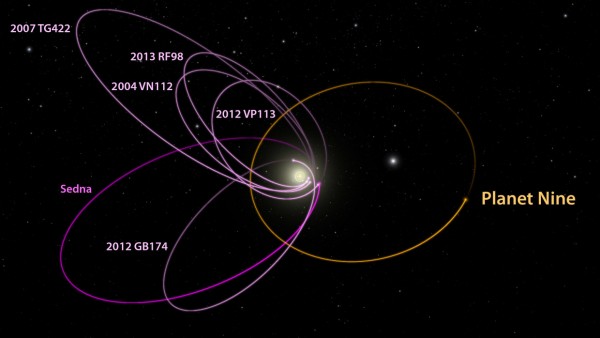Caltech announced on January 20, 2016 that its astronomers now have solid theoretical evidence for a giant planet – a 9th major planet in the outer solar system – moving in what they called a “bizarre, highly elongated orbit.” They’ve nicknamed it Planet 9 and hope other astronomers will search for it.
If it exists, the planet has a mass about 10 times that of Earth and orbits about 20 times farther from the sun on average than Neptune, which is currently the 8th major planet and which orbits the sun at an average distance of 2.8 billion miles (4.5 billion km).
The astronomers say it would take this new planet between 10,000 and 20,000 years to make just one full orbit around the sun.
Astronomers Konstantin Batygin and Mike Brown said they discovered the planet’s possible existence through mathematical modeling and computer simulations. The Astrophysical Journal published their study on January 20. They have not yet observed the object directly, but hope their theoretical work will encourage other astronomers to search for it.
Mike Brown describes himself as the astronomer who killed Pluto. In a January 20 statement from Caltech, Brown gave a nod to Pluto’s demotion from full planet status in 2006 – and indicated that he believes the large mass of the undiscovered planet would surely cause the International Astronomical Union to give it full planet status – when he commented:
This would be a real ninth planet.
There have only been two true planets discovered since ancient times [Uranus and Neptune], and this would be a third.
It’s a pretty substantial chunk of our solar system that’s still out there to be found, which is pretty exciting.
The new planet – if it exists – would be some 5,000 times the mass of Pluto.
Read Batygin and Brown’s paper, here.

Evidence for Planet 9 has been expected. A major planet on the outskirts of our solar system helps explain a number of mysterious features of the field of icy objects and debris beyond Neptune known as the Kuiper Belt. Astronomer Batygin said:
Although we were initially quite skeptical that this planet could exist, as we continued to investigate its orbit and what it would mean for the outer solar system, we become increasingly convinced that it is out there.
For the first time in over 150 years, there is solid evidence that the solar system’s planetary census is incomplete.
Read more at CalTech’s website.
Bottom line: Astronomers have not discovered a 9th major planet orbiting on the outskirts of our solar system, but the recent work by Caltech astronomers gives the astronomical community solid theoretical evidence that a 9th planet does exist. If so, armed with the new theoretical predictions, observational astronomers might be able to locate the planet.











